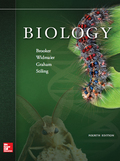
Concept explainers
Introduction: The general term ‘salt’ is used to refer to a compound formed by an attraction between a positively charged ion, such as sodium (
Answer to Problem 1TY
Correct answer: A change in the ion (salt) concentration in an animal’s body may result in altered membrane potentials. This disrupts normal cell function, certain biochemical processes that occur in the cell, and movement of water between fluid compartments. Hence, the correct answer is option e.
Explanation of Solution
Reason for correct answer:
The cell is said to be polarized at its resting state. The inside of the cell is negatively charged and it contains a high concentration of chloride ions. The outside of the cell is positively charged and it contains a high concentration of sodium ions. The changes in the concentration of ions from dissolved salts in the extracellular and intracellular fluids disturb the homeostasis and various important functions.
Option e. is given as “a, b, and c”.
The altered concentration of ions disturbs the membrane potential, biochemical processes, and flow of water. Hence, the correct answer is option (e).
Reasons for incorrect answer:
Option a. is given as, “altered membrane potentials that disrupt normal cell function”.
The change in the salt concentration in an animal’s body causes alteration in the membrane potential. This disrupts the normal cell function, for example, electrical potential across the plasma membrane in the cells of the heart and brain. However, it also disturbs the biochemical processes occurring in the cell and the water flow. Hence, option a. is incorrect.
Option b. is given as, “disruption of certain biochemical processes that occur in the cell”.
The change in the animal’s body ion concentration alters the biochemical process, for example, muscle contraction occurring in the cell. However, it also alters the membrane potential and movement of water. Hence, option b. is incorrect.
Option c. is given as, “movement of water between fluid compartments”.
The alteration in the ion concentration is also related to causing disturbance in the movement of water across the membrane. However, it also results in causing disturbance in membrane potential and certain biochemical processes. Hence, option c. is incorrect.
Option d. is given as, “a and b only”.
The alteration in the ion concentration in an animal’s body result in causing disturbance in the membrane potential, biochemical processes occurring in the cell, and movement of water between fluid compartments. Hence, option d. is incorrect.
Hence, the options a., b., c., and d. are incorrect.
The change in the ion (salt) concentration in an animal’s body may result in altered membrane potentials that disrupt the normal cell function, certain biochemical processes occurring in the cell, and movement of water between fluid compartments.
Want to see more full solutions like this?
Chapter 49 Solutions
EBK BIOLOGY
- Molecular Biology Question A gene that codes for a protein was removed from a eukaryotic cell and inserted into a prokaryotic cell. Although the gene was successfully transcribed and translated, it produced a different protein than it produced in the eukaryotic cell. What is the most likely explanation?arrow_forwardMolecular Biology LIST three characteristics of origins of replicationarrow_forwardMolecular Biology Question Please help. Thank you For E coli DNA polymerase III, give the structure and function of the b-clamp sub-complex. Describe how the structure of this sub-complex is important for it’s function.arrow_forward
- Molecular Biology LIST three characteristics of DNA Polymerasesarrow_forwardMolecular Biology RNA polymerase core enzyme structure contains what subunits? To form holo enzyme, sigma factor is added to core. What is the name of the structure formed? Give the detailed structure of sigma factor and the function of eachdomain. Please help. Thank youarrow_forwardMolecular Biology You have a single bacterial cell whose DNA is labelled with radioactiveC14. After 5 rounds of cell division, how may cells will contain radioactive DNA? Please help. Thank youarrow_forward
- 1. Explain the structure and properties of atoms and chemical bonds (especially how they relate to DNA and proteins). Also add some pictures.arrow_forward1. In the Sentinel Cell DNA integrity is preserved through nanoscopic helicase-coordinated repair, while lipids in the membrane are fortified to resist environmental mutagens. also provide pictures for this question.arrow_forwardExplain the structure and properties of atoms and chemical bonds (especially how they relate to DNA and proteins). Also add some pictures.arrow_forward
- In the Sentinel Cell DNA integrity is preserved through nanoscopic helicase-coordinated repair, while lipids in the membrane are fortified to resist environmental mutagens. also provide pictures for this question.arrow_forward1. Explain how genetic information is stored, copied, transferred, and expressed. Also add some pictures for this question.arrow_forward!. Describe biological macromolecules (DNA, RNA, proteins, lipids, etc.) and how they function in the cell. also provide some images for this question.arrow_forward
 Human Anatomy & Physiology (11th Edition)BiologyISBN:9780134580999Author:Elaine N. Marieb, Katja N. HoehnPublisher:PEARSON
Human Anatomy & Physiology (11th Edition)BiologyISBN:9780134580999Author:Elaine N. Marieb, Katja N. HoehnPublisher:PEARSON Biology 2eBiologyISBN:9781947172517Author:Matthew Douglas, Jung Choi, Mary Ann ClarkPublisher:OpenStax
Biology 2eBiologyISBN:9781947172517Author:Matthew Douglas, Jung Choi, Mary Ann ClarkPublisher:OpenStax Anatomy & PhysiologyBiologyISBN:9781259398629Author:McKinley, Michael P., O'loughlin, Valerie Dean, Bidle, Theresa StouterPublisher:Mcgraw Hill Education,
Anatomy & PhysiologyBiologyISBN:9781259398629Author:McKinley, Michael P., O'loughlin, Valerie Dean, Bidle, Theresa StouterPublisher:Mcgraw Hill Education, Molecular Biology of the Cell (Sixth Edition)BiologyISBN:9780815344322Author:Bruce Alberts, Alexander D. Johnson, Julian Lewis, David Morgan, Martin Raff, Keith Roberts, Peter WalterPublisher:W. W. Norton & Company
Molecular Biology of the Cell (Sixth Edition)BiologyISBN:9780815344322Author:Bruce Alberts, Alexander D. Johnson, Julian Lewis, David Morgan, Martin Raff, Keith Roberts, Peter WalterPublisher:W. W. Norton & Company Laboratory Manual For Human Anatomy & PhysiologyBiologyISBN:9781260159363Author:Martin, Terry R., Prentice-craver, CynthiaPublisher:McGraw-Hill Publishing Co.
Laboratory Manual For Human Anatomy & PhysiologyBiologyISBN:9781260159363Author:Martin, Terry R., Prentice-craver, CynthiaPublisher:McGraw-Hill Publishing Co. Inquiry Into Life (16th Edition)BiologyISBN:9781260231700Author:Sylvia S. Mader, Michael WindelspechtPublisher:McGraw Hill Education
Inquiry Into Life (16th Edition)BiologyISBN:9781260231700Author:Sylvia S. Mader, Michael WindelspechtPublisher:McGraw Hill Education





